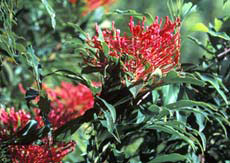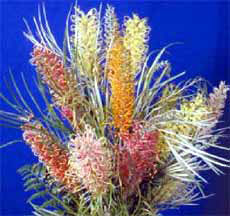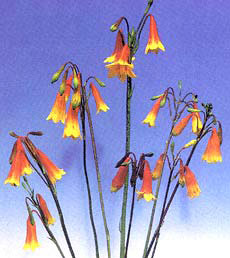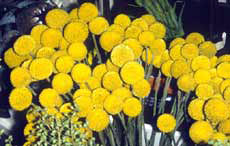
Potential or very new crops
The information in this document forms part of the publication Growing Australian native flowers commercially.

Alloxylon
Photo: Royal Botanic Gardens, Sydney
Alloxylon flammeum and A. pinnatum
Both of these tropical species have the potential to be an excellent competitor for the standard waratah, with a flower halfway between a waratah and a grevillea. The striking flower has the bonus of a much higher packout rate than waratahs (allowing more cost-effective freight). Both are currently grown in small numbers only.
Banksia species
Banksias are used for both their flowers and foliage. The trend is towards species with smaller heads. Banksias need to have a terminal flowering habit to be suitable for blooms. Examples being grown include:
- B. ericifolia
- B. integrifolia
- B. plagiocarpa
- B. robur
- B. × ‘Giant Candles’.
Key references
Sedgley, M 1998, ‘Banksias’, in The New Rural Industries — A Handbook for Farmers and Investors, RIRDC, Canberra.
Carson, C et al. 2000, ‘Banksia — east coast selected longer stemmed variants only’, in Should I grow wildflowers?, Agrilink Horticulture Series QAL 0001, Queensland Department of Primary Industries, Brisbane. For more information contact Queensland Department of Primary Industries.
Grevillea species

Grevillea
Photo: Peter Abell
Grevillea is another genus that is well known in Australia but is generally deemed to have a vase life that is too short for cut flower production. The development of postharvest protocols and the selection of varieties with a long vase life are overcoming this. This should help increase the currently low levels of production.
Other evidence from growers experimenting with some of the tropical hybrids on the domestic market suggest that the vase life is acceptable for at least a few of these hybrids such as G. ‘Moonlight’ and G. ‘Majestic’. This is further supported by the current popularity of a relatively ordinary Grevillea called ‘Spiderman’, which is being produced in Israel and apparently sweeping the European market.
There are opportunities for further breeding of grevilleas to obtain more cut flower varieties.
Key reference
Treble, K 2002, ‘Grevilleas with a 14 day postharvest life’, in Proceedings 6th Australian Wildflower Conference, 30 May–1 June 2002, Warwick Farm, Sydney. Copies available from NSW Department of Primary Industries.
Ptilotus species
This crop produces feathery cylindrical flower spikes with a long vase life. They can be used fresh as well as dried. Both P. exaltatus and P. obovatus are being grown, but they are best suited to drier inland regions with low incidence of frost. This native crop is unusual in that the first harvest can be achieved in as little as 12 weeks from planting.
Key references
Carson, C 2000, ‘Ptilotus’, in Should I grow wildflowers?, Agrilink Horticulture Series QAL 0001, Queensland Department of Primary Industries, Brisbane. For more information contact Queensland Department of Primary Industries.
Williams, RR 1996, ‘Ptilotus’, in Native Australian Plants — horticulture and uses, Johnson, K & Burchett, M (eds), University of New South Wales Press, Sydney.
Riceflower alternatives
These come in flower colours of white, yellow and green, and include the following:
- Ozothamnus diotophyllus
- Cassinia laevis
- Cassinia aureo-nitens
- Chrysocephalum semipapposum.
These species have the opportunity to extend the range of forms of ‘riceflower’ style product in much the same way as a number of Chamelaucium species and hybrids have substituted or replaced C. uncinatum (Geraldton Wax). However, as with the early development of riceflower, much work still needs to be done before many aspects relating to the cultivation of these species are well understood.
Key references
Bunker, KV 1996, ‘Native daisies’, in Native Australian Plants — horticulture and uses, Johnson, K & Burchett, M (eds), University of New South Wales Press, Sydney.
Carson, C et al. 2000, ‘Cassinia and Ozothamnus species complementary to rice flower’, in Should I grow wildflowers?, Agrilink Horticulture Series QAL 0001, Queensland Department of Primary Industries, Brisbane. For more information contact Queensland Department of Primary Industries.
Tropical foliages
Many new tropical foliages, particularly of proteaceous species, have started to reach the domestic market in recent years. Species of particular note include:
- Opisthiolepis heterophylla (Goldbacks)
- Stenocarpus davallioides (Fernleaf Stenocarpus)
- Darlingia darlingiana (Brown Silky Oak).
Their acceptance by the market will depend on their availability and long vase life, and on the education of florists.
Other crops with potential
Many other species have the potential to be cultivated for the flower trade. These are listed below.
Blandfordia grandiflora (Christmas bells, Festival bells)

Blandfordia grandiflora
These produce striking bell-shaped terminal flowers and can be red, yellow or commonly red with a yellow edge. They require careful attention to weed management.
To date, only a few dedicated growers are successfully cultivating this species.
Key references
Dick, G, Dalley, P & Gollnow, B July 1996, Growing Blandfordia commercially, Agnote DPI-148, first edition, NSW Department of Primary Industries (then NSW Agriculture).
Johnson, K 1998, ‘Blandfordia’, in The New Rural Industries — A Handbook for Farmers and Investors, RIRDC, Canberra.
Boronia
Several boronia species (mostly B. heterophylla and hybrids like B. ‘Lipstick’ and B. ‘Carousel’) are cultivated for their cut flowers. The flowering season is relatively short (up to 2 weeks in a given location). In NSW it has become a focus crop on the Far South Coast, where long-stemmed high quality product is available early in the season.
It is a medium-term crop (up to 5 years), but severe losses due to root rot diseases have been experienced early in the production cycle. Grafting cut flower varieties onto disease-tolerant rootstocks offers great potential to overcome this.
Currently US market access for boronia and other cut flowers from the family Rutaceae is restricted due to disease concerns.
Key references
Lidbetter, J et al. 2002, ‘Boronias that don’t drop dead’, in Proceedings 6th Australian Wildflower Conference, 30 May–1 June 2002, Warwick Farm, Sydney. Copies available from NSW Department of Primary Industries.
Plummer, JA 1998, ‘Boronias’, in The New Rural Industries – A Handbook for Farmers and Investors, RIRDC, Canberra.
Crowea exaltata
This crop features pink, waxy, star-like flowers and has a relatively long flowering period (late summer to winter).
Croweas are susceptible to root and collar rots, but they are more tolerant of these diseases than boronias.
Epacris microphylla, E. obtusifolia
These plants flower from winter to summer and require moist well-drained soil.
Helipterum roseum (Rhodanthe chlorocephala subspecies rosea), H. manglesii
These are pink, red and white paper daisies, grown as an annual spring-flowering crop. They are raised from seed. Helipterums can be used fresh or dried.
Key references
Bunker, KV 1996, ‘Native daisies’, in Native Australian Plants — horticulture and uses, Johnson, K & Burchett, M (eds), University of New South Wales Press, Sydney.
Carson, C et al. 2000, ‘Everlasting daisies’, in Should I grow wildflowers?, Agrilink Horticulture Series QAL 0001, Queensland Department of Primary Industries, Brisbane. For more information contact Queensland Department of Primary Industries.
Isopogon species (Drumsticks)
NSW species grown for the flower trade are:
- I. anemonifolius
- I. anethifolius
- I. dawsonii.
They produce cream or yellow flowers. The foliage and the fruit (cones) are also marketed.
WA species have more spectacular flowers (e.g. I. cuneatus) but they are harder to grow in much of NSW.
Leptospermum species and hybrids
Leptospermum was for many years the forgotten Myrtaceae genus because of a widely held belief that none of the species had an acceptable vase life. In recent years varieties such as ‘Lavender Queen’ have emerged and been embraced by the market.
Current research at the Victorian Department of Primary Industries has seized on this opportunity, leading to the selection of several hundred forms of Leptospermum and the development of new hybrids. Time will determine how successful these new varieties will be. This research has highlighted the fact that there are significant varietal differences in susceptibility to ethylene-induced flower drop, and that damage in susceptible forms can be prevented using silver thiosulfate (STS).
Key references
Carson, C et al. 2000, ‘Leptospermum (Tea tree)’, in Should I grow wildflowers?, Agrilink Horticulture Series QAL 0001, Queensland Department of Primary Industries, Brisbane. For more information contact Agrilink Manager, Department of Primary Industries, PO Box 5269 SCMC, Nambour QLD 4560.
RIRDC, Leptospermum as an export cut flower crop, RIRDC Publication No. 01/056.
Melaleuca uncinatum (e.g. ‘Wattle Gold’)
Several melaleuca species can be grown for year-round foliage as well as spring-flowering stems.
Key reference
Carson, C et al. 2000, ‘Melaleuca, Honey myrtle, Paper-bark’, in Should I grow wildflowers?, Agrilink Horticulture Series QAL 0001, Queensland Department of Primary Industries, Brisbane. For more information contact Queensland Department of Primary Industries.
Persoonia spp. (Geebungs)
Several persoonias have an established demand in the domestic market for their foliage and sprays of flowers due to the availability of bush-harvested product, for example P. pinifolia.
Persoonias are difficult to propagate and this is limiting commercialisation. To date they are only being cultivated by a small number of growers.
Key reference
Ketelhohn, LM, Johnson, ME & Gage, J 1996, ‘Persoonia virginata’, in Native Australian Plants — horticulture and uses, Johnson, K & Burchett, M (eds), University of New South Wales Press, Sydney.
Pimelea
Some species, for example P. rosea, produce terminal flower heads and are suitable as cut flowers. However, to date, most have been bush-harvested rather than cultivated. Pimelia nivea is grown for its foliage.
Key reference
Slater, AT 1996, ‘Pimelea’, in Native Australian Plants — horticulture and uses, Johnson, K & Burchett, M (eds), University of New South Wales Press, Sydney.
Pycnosorus globosa, syn. Craspedia globosa (Billy buttons)

Pycnosorus globosa
The plant produces globular heads of bright yellow flowers on long, straight, bare stems.
Sedges, ferns and mosses
Many of the interesting plants in this group have previously been market-tested using bush-picked product. With changing legislation and potential opportunities to improve quality, this area is beginning to attract interest. Genera of possible interest include:
- Caustis blakei
- Sticherus flabellatus
- Restio
- Gleichenia
- Lycopodium.
Key reference
RIRDC, The propagation and horticultural development of Caustis blakei for the export cut foliage market, RIRDC publication No. SR 52.
Thryptomene (Thryptomene, Victorian laceflower)
Thryptomene calycina is grown for its dense sprays of small white or pink tea-tree-like flowers, with commercial production centred in western Victoria.
Other species of Thryptomene also have potential for the cut flower market (e.g. T. saxicola), but relatively little work has been done to develop improved forms or to determine their cultivation needs.
Key references
Beardsell, DV 1996, ‘Thryptomene, Micromyrtus and Scholtzia’, in Native Australian Plants — horticulture and uses, Johnson, K & Burchett, M (eds), University of New South Wales Press, Sydney.
Beardsell, DV & Slater, AT 1998, ‘Thryptomene’, in The New Rural Industries — A Handbook for Farmers and Investors, RIRDC, Canberra.

